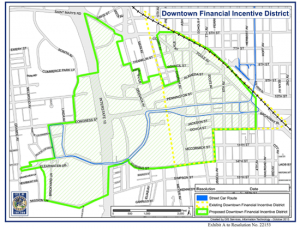ULI Panel: Give Free Market a Chance Tucson (Part 2 of 2)

We reported recommendations made by the independent panel from the Urban Land Institute for Downtown Tucson Market Forces, Retail Trade Area and Tucson Convention Center. Part One was published yesterday, and this is the second part of our report.
The Urban Land Institute (ULI) advisory panel presented their findings to a room of about 200 people at the Tucson Convention Center on Friday. The ULI panel consisted of seven independent volunteers from real estate related disciplines were commissioned to address such issues as: market forces, best land use, retail, quality of life issues, and implementation for Downtown Tucson development. The panel interviewed 150 people during their week-long stay in Tucson.
The candid and unbiased input from these professionals was summarized in their report that stressed the importance of prioritizing projects, taking small steps towards long-term goals, while creating synergy within the community and leveraging limited public resources to encourage private sector investment.
The study area as shown in the map included the panel focusing on downtown Tucson, the TIF District, the Streetcar route and east and west side of I-10 in this area.
Streets in the District
Street have a role in setting the desert scale and serve to match service to demand. Parking needs to be strategically thought out for development and temporary events. Fortunately, the district is walkable, given proper signage of walkways for people to park and get to their destinations.
There are currently oversized streets for their traffic volume. Streets such a Church north of Broadway could be converted for street parking. The panel warned to beware of closing any streets and suggested adding streets back to the super blocks where possible.
Quality of life is closely related to how easy it is to move around downtown. The panel emphasized that bikes and streetcars are not compatible, and bike paths should be separated away from the streetcar route. The fixed Stravenues could also help bikers get around and keep them safely separated from the streetcar.
Implementation
The implementation of revitalization in downtown depends upon the strengthening of civic engagement and cooperation between the stakeholders. It is recommended that an ongoing advisory committee be established that would comprise one member from each of the following: City of Tucson, Pima County, Rio Nuevo, University of Arizona, Public Transportation, Neighborhood Groups, Retail, Developers, Non-governmental agencies, and office owners. The panel stressed the importance of an advisory committee being representative of the stakeholders and not comprise elected officials of the government organization. The advisory committee members would act as liaisons to serve on the advisory committee.
Other recommendations the panel made were to have an IT master plan that would include data collection, for instance pedestrian count today should be measured for date to compare later in the district. Transparency was also brought up as important to engage civic participation and support. A Citizen Ombudsman would go a long way in assisting developer and citizen issues / problems as they arise.
Downtown Tucson Partnership could be used to bring temporary events to the TCC, a temporary miniature golf course that was set up in Philadelphia for 30-days was used as an example of this. This allows for small steps to be taken that would increase pedestrian activities downtown without spending a lot of money.
Another example, was the use of the fountains at TCC which are in disrepair. The panel recommended that not all the fountains be activated at once, but maybe just the one in front of the Music Hall could be made to function and help the aesthetic appearance at this entrance.
Recommended La Placita be donated by the City for activities such as educational activities like children’s visits to the museum.
A digital public walking tour should also be considered, where visitors could click their cell phone to hear a brief history at certain spots, buildings, art pieces, etc.
In Summary:
The panel concluded that a detailed market analysis would be of benefit to determine market rates for multifamily. This would encourage a hotel development to the area and determine current office space in the district.
Economically, there are no sources for funding and fortunately for Tucson the TIF district was established. That, with free market forces working together can make this happen; but it will be done only with patience and teamwork. The public sources cannot do it without private capital and vice versa. Think small steps, a new arena is not needed unless the current TCC would be at full capacity.
It is as Mayor Jonathan Rothschild said in his opening remarks at the meeting, “This may be Tucson’s last chance to get it right.”
The volunteer panel members from the Urban Land Institute consisted of the following members: John Walsh, Alan Billingsley, Michael Berne, Charlie Johnson, Ross Tilghman, Peter Hasselman, and Jan Minana. The study was a public and private joint effort of Pima County, the City of Tucson, Rio Nuevo, Pima Association of Governments, Visit Tucson, Tucson Electric Power and Holualoa Companies who paid for the study.